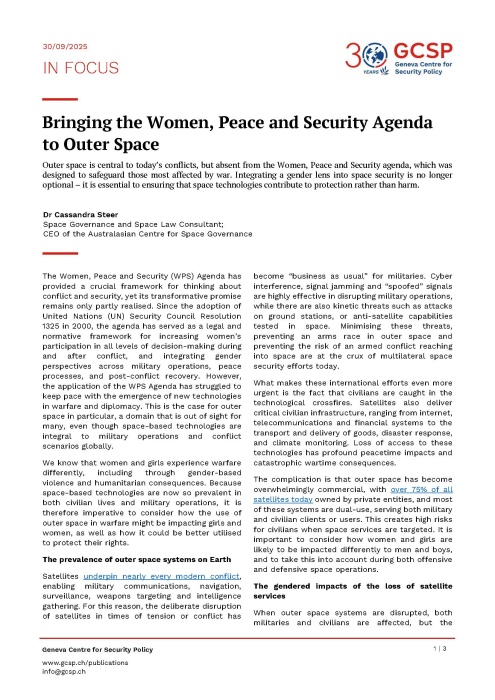Bringing the Women, Peace and Security Agenda to Outer Space
Outer space is central to today’s conflicts, but absent from the Women, Peace and Security agenda, which was designed to safeguard those most affected by war. Integrating a gender lens into space security is no longer optional – it is essential to ensuring that space technologies contribute to protection rather than harm.
The Women, Peace and Security (WPS) Agenda has provided a crucial framework for thinking about conflict and security, yet its transformative promise remains only partly realised. Since the adoption of United Nations (UN) Security Council Resolution 1325 in 2000, the agenda has served as a legal and normative framework for increasing women’s participation in all levels of decision-making during and after conflict, and integrating gender perspectives across military operations, peace processes, and post-conflict recovery. However, the application of the WPS Agenda has struggled to keep pace with the emergence of new technologies in warfare and diplomacy. This is the case for outer space in particular, a domain that is out of sight for many, even though space-based technologies are integral to military operations and conflict scenarios globally.
We know that women and girls experience warfare differently, including through gender-based violence and humanitarian consequences. Because space-based technologies are now so prevalent in both civilian lives and military operations, it is therefore imperative to consider how the use of outer space in warfare might be impacting girls and women, as well as how it could be better utilised to protect their rights.
The prevalence of outer space systems on Earth
Satellites underpin nearly every modern conflict, enabling military communications, navigation, surveillance, weapons targeting and intelligence gathering. For this reason, the deliberate disruption of satellites in times of tension or conflict has become “business as usual” for militaries. Cyber interference, signal jamming and “spoofed” signals are highly effective in disrupting military operations, while there are also kinetic threats such as attacks on ground stations, or anti-satellite capabilities tested in space. Minimising these threats, preventing an arms race in outer space and preventing the risk of an armed conflict reaching into space are at the crux of multilateral space security efforts today.
What makes these international efforts even more urgent is the fact that civilians are caught in the technological crossfires. Satellites also deliver critical civilian infrastructure, ranging from internet, telecommunications and financial systems to the transport and delivery of goods, disaster response, and climate monitoring. Loss of access to these technologies has profound peacetime impacts and catastrophic wartime consequences.
The complication is that outer space has become overwhelmingly commercial, with over 75% of all satellites today owned by private entities, and most of these systems are dual-use, serving both military and civilian clients or users. This creates high risks for civilians when space services are targeted. It is important to consider how women and girls are likely to be impacted differently to men and boys, and to take this into account during both offensive and defensive space operations.
The gendered impacts of the loss of satellite services
When outer space systems are disrupted, both militaries and civilians are affected, but the gendered impacts are often overlooked. In regions where gender inequality is already pronounced, these disruptions compound existing vulnerabilities.
Forced displacement, infrastructure loss, and economic hardship during conflict often hit women and girls hardest. Communication collapse impedes access to support and relief services, which multiplies threats for women and girls. The loss of location and timing signals undermines humani-tarian operations, which can lead to greater health impacts on mothers caring for children and to greater vulnerability to gender-based violence.
To ignore these effects is to ignore the second – and third-order harms of space-based conflict on civilian populations, and on women and girls in particular – harms that the WPS framework was specifically designed to mitigate.
Outer space’s role in protecting women’s and girls’ rights
The WPS Agenda is structured around four pillars: participation, protection, prevention, and relief and recovery. Whereas the gendered impacts of the loss of satellite service falls under the “prevention” pillar, applying a gender lens to the deployment of outer space capabilities can serve the “protection” and “relief and recovery” pillars.
For example, Earth observation satellites can provide near real-time data on displacement and gender-based violence; communications satellites can sustain connectivity and access to online education during conflict; and position, navigation, and timing systems can support safe movement during conflict and can secure women’s access to funds through remote payment systems, an essential stabiliser post-conflict.
Participation as prevention
The “participation” pillar of the WPS Agenda is also essential to decision-making in outer space operations. Without women at the table, the gendered implications of space conflict are less likely to be considered, much less addressed. This is especially important in times of crisis, when a gender lens should be part of standard operating procedures.
When women are involved in decision-making at all levels, including diplomatic, military, scientific, and commercial roles, the likelihood increases that gendered risks will be recognised and mitigated and the standard of decision-making in general will improve. For example, evidence-based research shows that when women participate in peace negotiations, the likelihood of a peace agreement lasting at least two years increases by 20% and the likelihood of it lasting 15 years increases by 35%, while the effectiveness of post-conflict governance also increases.
Yet the outer space sector remains deeply gender imbalanced. Women continue to be under-represented in space agencies, defence depart-ments, diplomatic delegations and commercial satellite industries. Globally, women represent less than 20% of the space sector, which has remained unchanged for more than 30 years. Women hold less than a quarter of management and executive roles in space-related careers, and make up less than 14% of all military roles, with a lower percentage likely in outer space roles. Having more women operating, advising, and making decisions on offensive space operations and the deployment of space capabilities to protect civilians’ rights is essential, as is embedding gender advisors and WPS experts in all military space divisions.
WPS and outer space diplomacy
Another aspect of the “participation” pillar is the improved quality of multilateral decision-making and negotiations. As a recent UN report puts it, “Women’s equal participation in international domains is correlated with everything from higher levels of collaboration and consensus to longer-lasting peace”. It is therefore essential that diplomatic delegations to outer space security forums include gender advisors and female experts in meaningful roles. Currently, only 33% of diplomats taking part in these space security discussions are women. Applying the WPS Agenda to space is about greater operational effectiveness and human security, yet arms control dialogues rarely include a gender perspective, risking the same inequities that the agenda was designed to address.
International diplomats have an opportunity to ensure that WPS principles are integrated into future iterations of multilateral agreements on outer space security. This includes updating national action plans on WPS to explicitly include space systems and technologies. It also means ensuring that emerging norms on responsible behaviour in outer space reflect gender-sensitive approaches to targeting, attribution, transparency and verification.
Conclusion
Embedding WPS principles into military outer space operations, government decision-making and diplomatic efforts is not about expanding mandates, but about fulfilling existing ones. The consequences of failing to do so are not only moral, but also strategic: perpetuating gender-blind policies undermines both the legitimacy and effectiveness of international space security initiatives, while failing to engage women in planning and decision-making risks ineffective military operations and second-order harms to the very civilians these operations aim to protect. As states advance their space capabilities, policies and collaborative operations, there is an opportunity to embed the WPS Agenda as standard operating procedure. Doing so can contribute to the best possible outcomes for the role of outer space in resolving 21st-century conflicts.
Disclaimer: The views, information and opinions expressed in this publication are the author’s/authors’ own and do not necessarily reflect those of the GCSP or the members of its Foundation Council. The GCSP is not responsible for the accuracy of the information.


